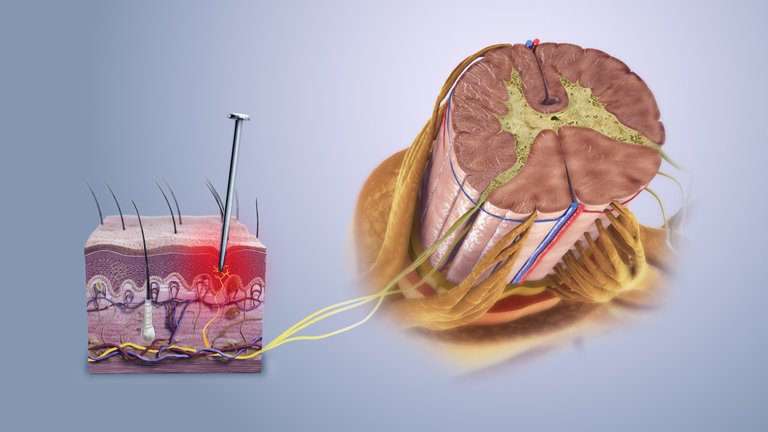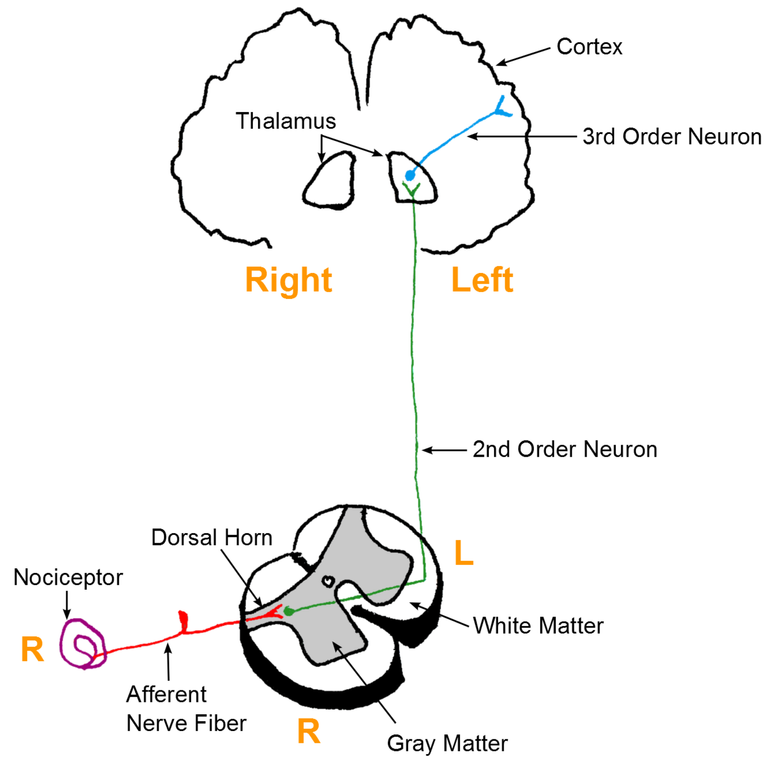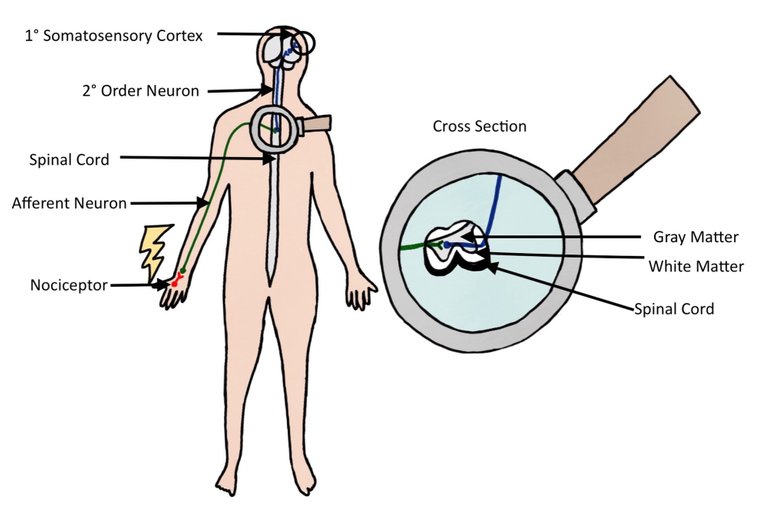The aetiology and panacea of pain: exploring the orthodox and modern approaches to alleviation of pain in humans - 1
Today's discussion will go two ways, our focus for now will be to critically explain basic things about pain. Subsequently, we will discuss how healing, tissue repair and how they are handled, quickened using a relatively new or more or less ancient but redefined technique in medicine.
There have been various alternative to medicine practices and procedures that have so far been seen to be productive and effective in healing of injured tissues. These procedures usually are less invasive and most times does not involve any complexities of any kind. The goal has always been to reduce pain at all costs.
In one of my previous article, I succinctly explained how energy medicine influences tissue and wound healing process without having to apply any form of invasive therapeutic approach. You can read more about the concept of energy medicine here - The concept of energy medicine exploring the indispensable use of scintillating optic glass fibres in clinical diagnosis.
Medical treatment has always been evolving and tilting towards procedures that will inflict minimal to zero pain to the patient. Till this is achieved, advancement in medicine will never end. In one of my earlier article, I discussed hoe sound wave can be applied to injured tissue to facilitate and speed up healing process.
Today's discussion will go a bit further to discuss some other techniques aside the use of drugs to facilitate faster way to alleviate pain and also fast track wound healing. I think having a better understanding of what pain is, its etiology and how they are alleviated will help us understand better our discussion for today. So let's have a quick look at the pain in its totality. In our subsequent post, we will explain ways of alleviating pain traditionally and modern ways.
Etiology of pain
Pain is one thing that no matter how strong, big and tough you may think you are as a human, it can never be ignored when it comes. Pain can come through any means and it can either be self inflicted unconsciously or intentionally and it can also be as a result of external factors.
According to the International Association for the Study of Pain (IASP), the current revised definition of pain is an unpleasant sensory and emotional experience associated with, or resembling that associated with, actual or potential tissue damage.
Every living creature be it humans or other creatures generally have varying threshold for pain. How we react to these pains when they are inflicted also differs. Animals in strict sense of it have higher pain threshold when compared to humans. The skin covering the body and the depth of what is known as pain receptors plays a crucial role in pain perception, and this is one contributing factor to why the ability to feel pain greatly differs in individuals, as well as in animals.

Sensory nerve fibres stimulated beyond harmful intensity causing nociceptive pain
Spanking a goat, dog horse or even elephant with little energy might not yield much reaction from them as when compared to humans. Even among humans, there still exist some level of variation in pain reception. This begs the question, why? There are various reasons for this, and we will bring them into focus as we progress.
Pain can be of different types - chronic or acute pain. For chronic pain, they are those types of pain that do not go away quickly. They can persist longer than expected while acute pain are those types of pain have short duration effects. Acute pain do not last longer than expected, and they resolve on their own in time. This is just the classification of pain by definition of duration.
For pain to persist, there must be a underlying factor and origin. Pains don't just come, it is a subtle way for the body to react and give signal of a potential problem. Usually in less severe cases, they begin mild and overtime escalate. Acute pain could progress into chronic pain when left unattended.
Furthermore, when pain is defined by the source, then we could have either pain as a result of tissue damage also known as nociceptive pain, nerve damage also known as neuropathic pain or even caused psychological factors also known as psychogenic pain. The location from where the pain is originating from can also be used as a means of classifying the pain. The question now is, how do we feel this pain? What initiates the feeling?
How we feel pains
No matter the source or type of pain experienced by humans or animals strictly, there is one very pivotal point of focus through which these pains are transmitted; and this is through what is known as the nociceptors. Pain is in most cases experienced when the threshold for it has bee exceeded. That moment when s particular stimulus suddenly becomes uncomfortable for you is known as pain perception.
Pain signal can be activated mainly by three factors and they include chemical, mechanical and, physical stimuli. The receptors must be functional and sensitive to pain stimuli. Pain may be disfavoured by many, but the very important role they play in our lives cannot be e underestimated. Imagine putting your hand in a hot water and there is nothing practically to warn you of the devastating effects the hot water has on the skin.
The pain receptors are nociceptors. They are known to exist in muscle, joints, and skin. Each nociceptor has selective sensitivity to mechanical (muscle-fiber stretching), chemical (including lactic acid), and thermal stimuli.
Our ability to feel pain is dependent on the sensitivity of these nociceptors to pain and the concomitant transfer of this pain signal to the brain for interpretation and reaction. Pain receptors are among the receptors that are located deeper in the skin, muscles and even disceral organs.
The path of pain reception is governed by afferent neurons that transmits the pain signal to the cortex of the brain. Upon stimulation of the pain receptor, for instance, those located on the skin, the nociceptors detect this signal and then through the afferent neurons (nerve fibers) transmits the stimulus to the spinal cord.
The transmission of this stimulus to the spinal cord, happens through the left dorsal horn. Through the grey matter directly, this signal is transmitted to the white matter and further passes into the right horn and then its transmitted to the brain through the left 2nd order neuron. All these stops and pathways through which these pain signal pass have contributing effects in pain reception by the brain.
The hypothalamus plays a very crucial role in pain signal reception because it is directly involved in its modulation. They majorly process the stimulus signal received and relay them to the cerebral cortex for interpretation. Besides this function, the hypothalamus is very good at helping you discriminate the kind of pain signal received.
The three main functions and components of the hypothalamus in relation to their role in pain modulation are summarized to be inclusive of sensory discriminative, affective emotional and cognitive-evaluative components**. These three components are responsible for how we as humans and animals respond to pain.
The discriminative aspect focuses on evaluating the quality of the pain, where it is coming from, and then it checks the severity of the pain so that appropriate measurable response will follow. Furthermore, the affective-emotional is much more concerned about evaluating the unpleasant feeling that is associated with the pain while the last one which is the cognitive function is particular about keeping record of the events and preparing the brain ready for future occurrence.

Signal pathways for nociception
The cognitive function is more less like part of it that keeps memory of the events and how the pain felt. This is why in children, at first encounter with some hurtful substances, they innocently fall prey, but overtime, because they have record of such event, on subsequent encounter, they withdraw.
These scenario is in fact not only peculiar to children but also in adults. No one would want to experience the discomfort they get by having anything to do with some that instills pain rather they naturally dissociate from such stimulus. Once bitten, twice shine.
According to the reports by Nichole M. Emerson and colleagues, it has been shown that in some individuals with more densed grey matter, these individuals are less sensitive to pain than those with less dense grey matter.
Our results indicate an inverse relationship between pain sensitivity and grey matter density in areas of the DMN, such that individuals who are highly sensitive to pain have less grey matter in PCC and PCu, and individuals who are least sensitive to pain have more grey matter in these areas
The above could be presumed as the reason for the variations in pain threshold among humans. In a nutshell, the more grey matter you have, the lesser your ability of responding to pain and vice versa. Could this be said for animals? In as much as there is no gold standard for the assessment of pain in animals, evidences and reports have shown that other animals do feel pain just as humans do.
All mammals process the neuroanatomic and neuropharmacologic components involved in transduction, transmission, and perception of noxious stimuli; therefore, it is expected that animals experience pain even if they cannot exactly perceive or communicate it in the same way people do
The major difference lies in the pain threshold and tolerance. Pain tolerance threshold (that point pain becomes unbearable). Animals have higher tolerance threshold to pain than humans and one the reasons is because of their skin thickness. Pain receptors are thick bundle of nerve fibres and they form part of what is called the somatosensory system in the skin.
The somatosensory system is made up of four types of receptors, of which pain is one. They include mechanoreceptors, thermoreceptors, pain receptors, and proprioceptors. They work in unison to helps us characterize and differentiate between injurious pain signals and less harmful ones. They confer the ability to detect, touch and even sense any form of physical pressure. In the skin, the are located deeper in the muscle of animals than when compared to human skin.

In essence, it will take more physical pressure to reach the tolerance threshold in animals than in humans. This is one of the reasons, a horse can be hit using a riding crop as plenty times as often, and yet the effects will not be much pronounce as when compared to humans being hit in such manner. Though they may feel the pain, but its effects for sure cannot measure up what will be felt if it were to be humans.
These animals may not be able to express this pain appropriately, it is undeniable that they respond by running faster as a result of the pain instilled through the whip. This begs the question, is it morally ok to continue this practice. Animals have their rights to fair treatment at all times. Can we as humans really justify the use of this whip on these animals, absolutely not.
The need to protect the rights of these animals led to the push for the ban on the use of riding crops by jockeys on horses. I see the reason for this ban and I personally support it. Animals should be treated right and fair.
A good understanding of pain signal pathways have led the development of drugs and molecules that could effectively inhibit pain. As much as pain has crucial role to play, they also have negative sides and are in some cases not required. Inhibiting them brings relief to the victim.
A block in any of signal transmission pathway to the brain inhibits pain and this is the simple way through which some drugs work.
There are different substances or drugs that have the ability of inhibiting pain. We will pause this article here so that it doesn't get too bulky for consumption. In our subsequent article, we will a deeper dive into the mechanisms involved in pain inhibition. What are the various panacea to pain that abounds and how do they work? All these will reveal in the next article. Keep in touch.
In conclusion, pain is very important in human life just as comfort is also important. But the need to regulate them is also very important. Some surgical procedures require the inhibition of pain to be a success. Case in point, Caesarian sections require inhibition of pain momentarily while it is been done. A quick fact I would like to let you know, The brain is the only organ in the human body that does not feel pain. Do you know why? Join me next time as we round up the discussion.
References
•The revised International Association for the Study of Pain definition of pain: concepts, challenges, and compromises
•Pain as a disease: an overview
•Not All Pain is Created Equal: Basic Definitions and Diagnostic Work-Up
•Pain in Research Animals: General Principles and Considerations
•Pain Sensitivity is Inversely Related to Regional Grey Matter Density in the Brain
•The Role of the Thalamus in Modulating Pain
•Sense of Touch
•Association of racing commissioners international

Excellent post, I like It so much, congratulation, greetings 🙋🙋🙋
Thanks for the read.
Trust you are doing great.
La mayoría de los procedimientos o medicamentos son invasivos que afectan los tejidos, sobre todo si la afección es por alergias. Es bueno saber que ya existe la cura para los tejidos lesionados y que su debido uso no deja efectos secundarios o complejidades que se puedan lamentar en el futuro próximo.
Gracias @cyprianj por todos esos conocimientos que ha planteado en esta publicación.
Most procedures or medications are invasive and affect the tissues, especially if the condition is due to allergies. It is good to know that the cure for injured tissues already exists and that its proper use leaves no side effects or complexities to be regretted in the near future.
Thank you @cyprianj for all those insights you have raised in this publication.
Indeed they exist.
The ultimate goal has always been to have a treatment procedure with less invasiveness. I will discuss some of the techniques in the subsequent post.
Thanks for the read.
Thanks for your contribution to the STEMsocial community. Feel free to join us on discord to get to know the rest of us!
Please consider delegating to the @stemsocial account (85% of the curation rewards are returned).
Thanks for including @stemsocial as a beneficiary, which gives you stronger support.
💞
Congratulations!
✅ Good job. Your post has been appreciated and has received support from CHESS BROTHERS ♔ 💪
♟ We invite you to use our hashtag #chessbrothers and learn more about us.
♟♟ You can also reach us on our Discord server and promote your posts there.
♟♟♟ Consider joining our curation trail so we work as a team and you get rewards automatically.
♞♟ Check out our @chessbrotherspro account to learn about the curation process carried out daily by our team.
Kindly
The CHESS BROTHERS team
💞
@tipu curate 2
Upvoted 👌 (Mana: 25/45) Liquid rewards.
Thanks for the support 💞
Appreciative
Congratulations @cyprianj! You have completed the following achievement on the Hive blockchain and have been rewarded with new badge(s):
Your next target is to reach 135000 upvotes.
You can view your badges on your board and compare yourself to others in the Ranking
If you no longer want to receive notifications, reply to this comment with the word
STOPCheck out the last post from @hivebuzz:
Support the HiveBuzz project. Vote for our proposal!
Thank you 💓
You're welcome @cyprianj, it's well deserved! Congrats on your constant involvement on Hive 😊🌹
Suspense!!, I like it.
This was interesting, you had me glued till I was done. Can't wait for the next one.
Thanks for always turning up. Anxiously waiting to read some of ur works.
What is ur area of interest in medicine?
Thank you.
I'm yet to make up my mind.
I think you are a Stemsocial star. Every time I read one of your articles I am impressed by the depth and breadth of you knowledge. This is a really personal subject: who hasn't felt pain? So it is highly relevant to everyone
This takes a re-read, as do all your articles. So much to learn. Thank you.
Practically no one can say he or she hasn't felt pain ever with exception to people with congenital insensitivity to pain.
Your kind gesture of tips is just one of a kind. Deeply grateful and appreciative of this. It just simply shows your kindness.
Thanks once again and for often reading my works with keen interest and attention to details.
https://twitter.com/A_G_Moore/status/1562674555881025536
The rewards earned on this comment will go directly to the people( @agmoore ) sharing the post on Twitter as long as they are registered with @poshtoken. Sign up at https://hiveposh.com.